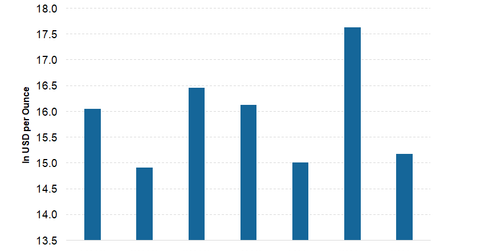Coeur Mining: What Could Lead to Cost Improvement in 2018
Coeur Mining (CDE) reported AISC (all-in sustaining costs) of $15.18 per ounce for 3Q17.
Dec. 1 2017, Updated 2:10 p.m. ET

Cost discipline
Coeur Mining (CDE) reported AISC (all-in sustaining costs) of $15.18 per ounce for 3Q17. Its latest unit costs represent a decline of 4% quarter-over-quarter. Higher production compared to the previous quarter was mainly responsible for lower unit costs.
Historically, Coeur has been a high-cost producer compared to its peers (SIL).
Drivers for cost performance
While higher production was one of the major reasons for the cost decline for CDE in 3Q17, more specifically, these factors contributed to the improvement:
- The production at Palmarejo increased in 3Q17, which led to lower unit costs. The adjusted cost of sales per unit at Palmarejo fell 14%.
- Lower costs at Palmarejo were offset to an extent by higher costs at San Bartolomé. Because of lower production due to drought conditions and inventory adjustment, the costs applicable to sales at San Bartolomé rose 22% year-over-year.
Cost expectations
Along with the decline in production guidance, the company also increased its cost guidance for 2017 to reflect the ongoing drought conditions at San Bartolomé. Coeur also increased the cost expectations for Rochester due to higher processing costs due to the residual effects of record rainfall earlier in the year. The cost guidance at Coeur’s Kensington mine was also increased to reflect higher year-to-date costs, driven by lower-than-expected gold grades. The new guidance is $16.25–$16.75 per silver equivalent ounce (or SEO) compared to $15.75–$16.25 per SEO originally. This guidance is based on the conversion of a 60:1 equivalent basis.
Coeur’s peers Silver Standard Resources (SSRI), Hecla Mining (HL), Pan American Silver (PAAS), Barrick Gold (ABX), and Newmont Mining (NEM) are also working to reduce their costs to manage volatility in the prices of precious metals.
